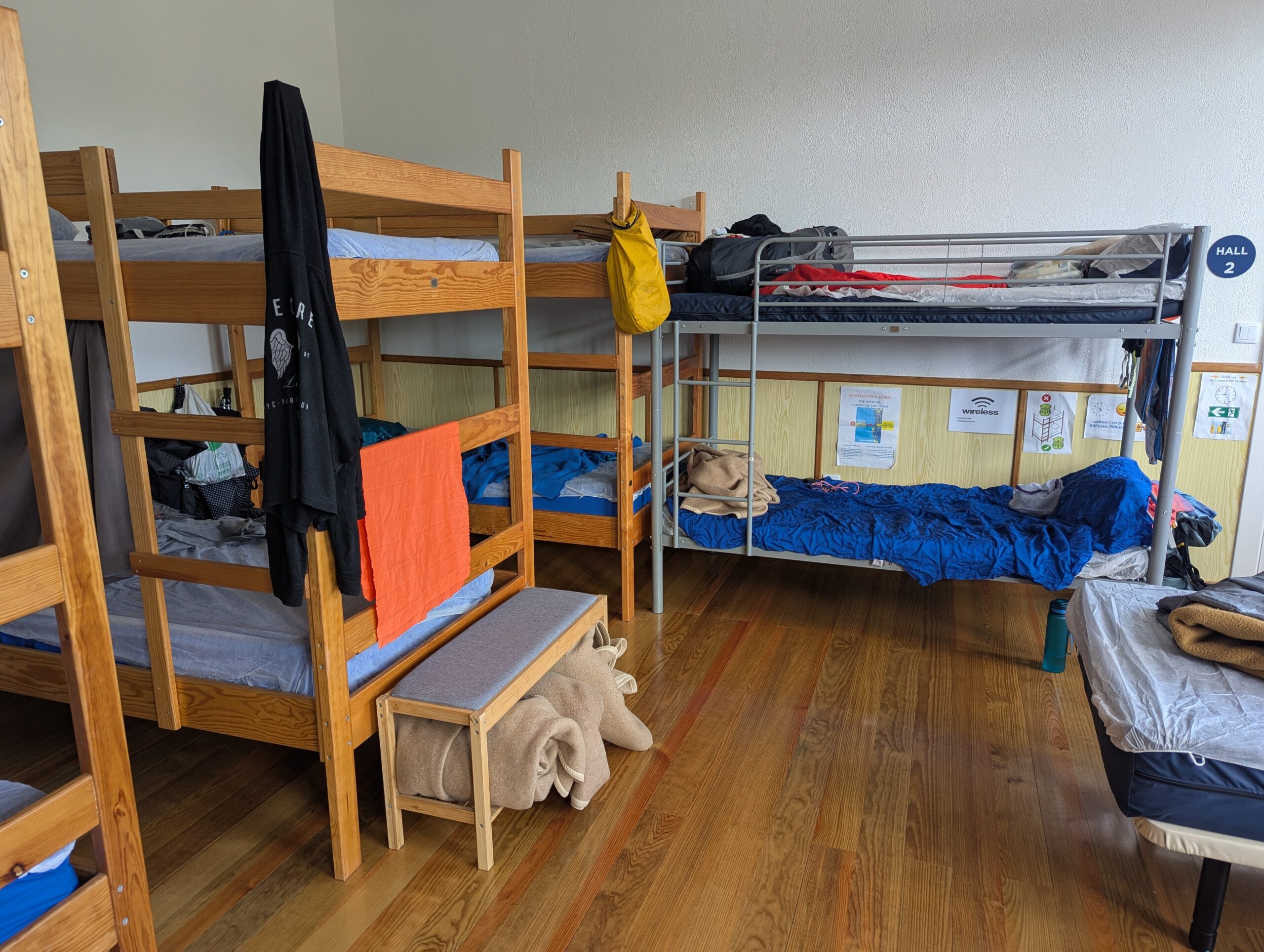This time I’m going to cover everything about the hostels on the Camino. Sleeping in a hostel? The question often sounds with some reservation. Yes, staying overnight on the Camino de Santiago mostly happens in a hostel. Do you want to know more about it? Then read on in this blog.
Will you sleep in hostels if you go on foot to Santiago de Compostela? Read here what you can expect in the private hostels or in the municipal hostels? What’s handy to have with you or what is often available in the hostels. Are you going to walk a Camino? Then definitely read on to be well prepared for life in the hostel on the Camino de Santiago.
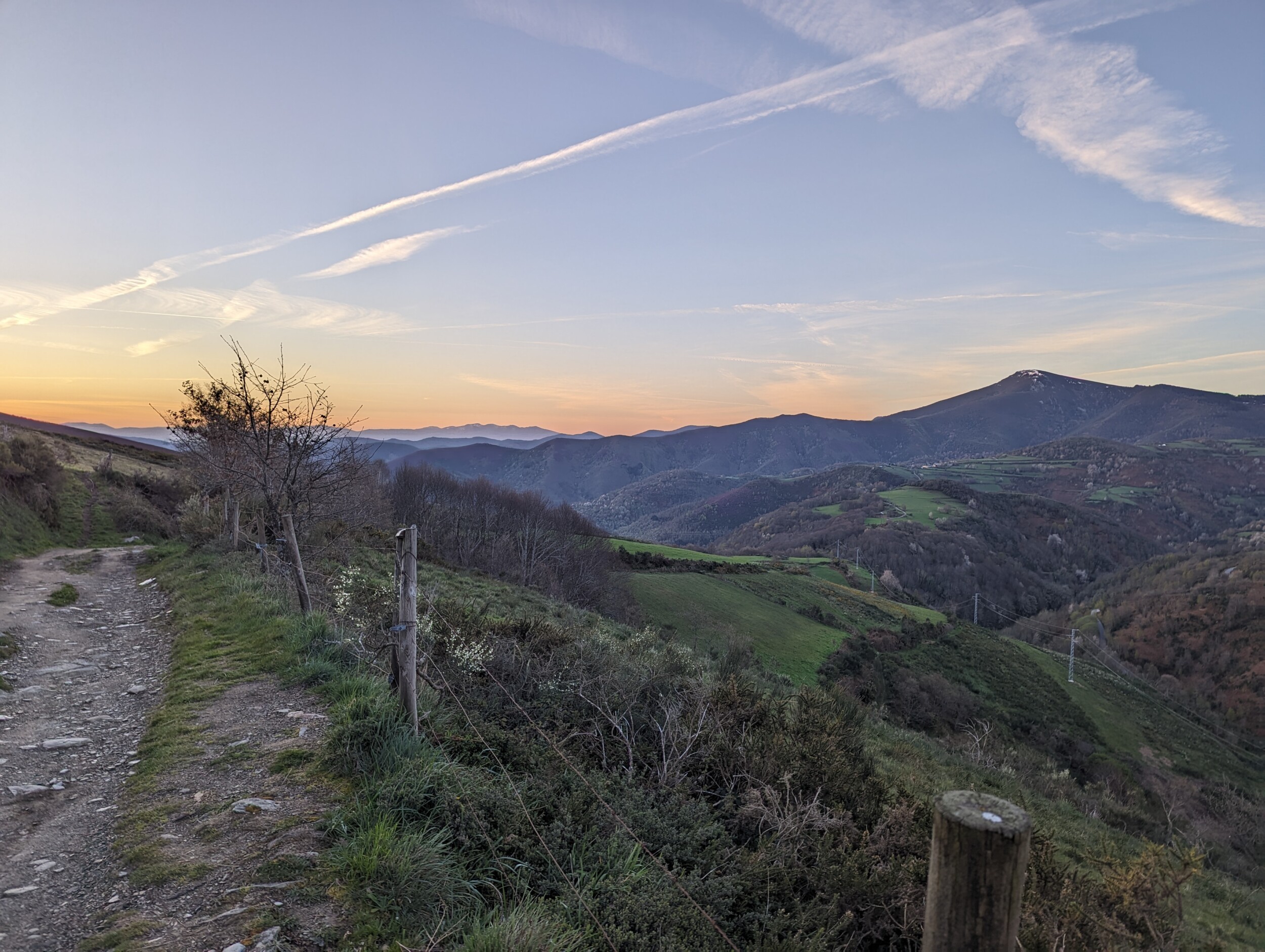
The first question I encounter is, where to stay overnight on the Camino de Santiago? On the Camino, most pilgrims sleep in hostels in dormitories with multiple pilgrims. My experience of my Camino was a great success precisely because of sleeping in the hostels. While for most people it’s actually the biggest obstacle not to walk a Camino. What a shame! With good preparation, you too can sleep in a hostel during your Camino de Santiago.
Read all about the hostels on the Camino
When you stay in hostels, you get to know many pilgrims. You share great tips but also your doubts and problems. The feeling of cohesion quickly increases because you share joys and sorrows with your fellow pilgrims. Yet I understand that you have doubts about sleeping in hostels, that you’re afraid of getting too little sleep and that it might prevent you from planning that pilgrimage after all.
What are hostels? Simple and cheap accommodations especially for pilgrims. Pilgrim hostels are called Albergues in Spain and in France they’re called Refugios.
General information about the hostels on the Camino
- Where do you sleep during the Camino de Santiago?
You can sleep in hotels but most pilgrims stay overnight on the Camino de Santiago in the hostels specially intended for pilgrims. There are a number of websites where you can find many hostels. These are the private hostels and therefore often also bookable.
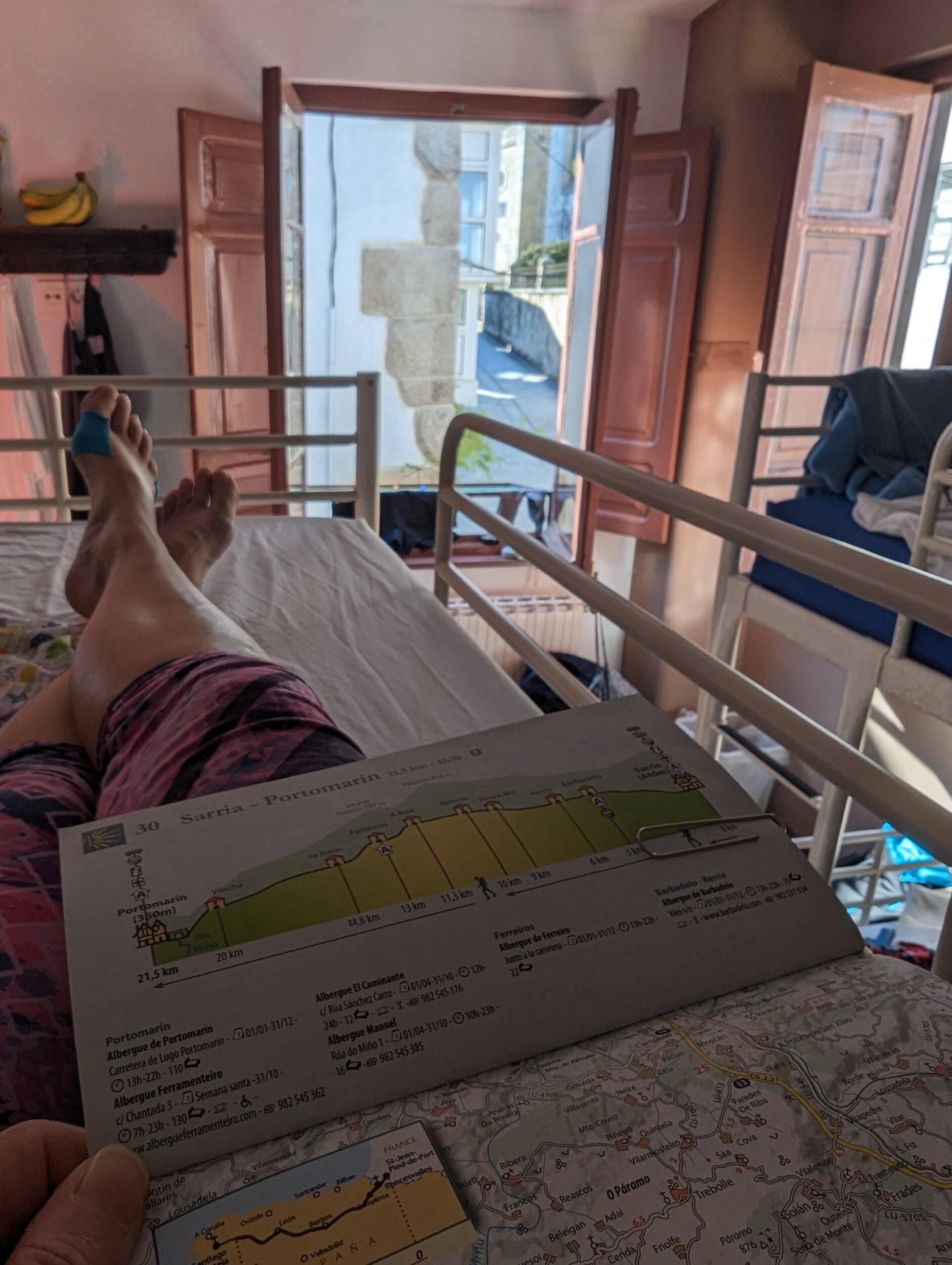
Check out the websites of caminosleeps or gronze or download the BuenCamino / Camino Ninja app.
Public (municipal and church) hostels cannot be reserved and are often not visible online either. Know that in every place along the Camino there are often multiple hostels and therefore there is a possibility to stay overnight. If you deviate from the fixed distances/stages, you have a better chance of getting a bed because most pilgrims walk the suggested distances/stages from the booklets.
- How big are the dormitories in the hostels?
In dormitories of the hostels there are sometimes 4 to 8 beds but sometimes also 25/30 (bunk) beds. If you don’t want to reserve, you can always inquire. Of course, you don’t have to stay at the first hostel if you find the hall too big/massive. As I said, usually a village has multiple hostels. Especially on the Camino Frances. On the less busy Norte or Portuguese there is less choice of hostels.
- Is there a kitchen in the hostel?
In almost every hostel there is a kitchen to make food and drinks. You can always use communal spaces where you can sit and prepare and consume your own food. Or just make a cup of tea/coffee. That’s the nice thing about hostels.
- Public hostels cannot be reserved in advance
A public hostel cannot be reserved in advance. There are different types of hostels and if you want to reserve in advance, you’ll end up in a private hostel. Because what types of hostels are there? There are private hostels and there are church and municipal hostels. The differences can be noticed in the prices and what they offer. The private ones are a bit more expensive but then often also a bit more luxurious and the municipal and church ones are often a bit more basic and therefore also a bit cheaper.
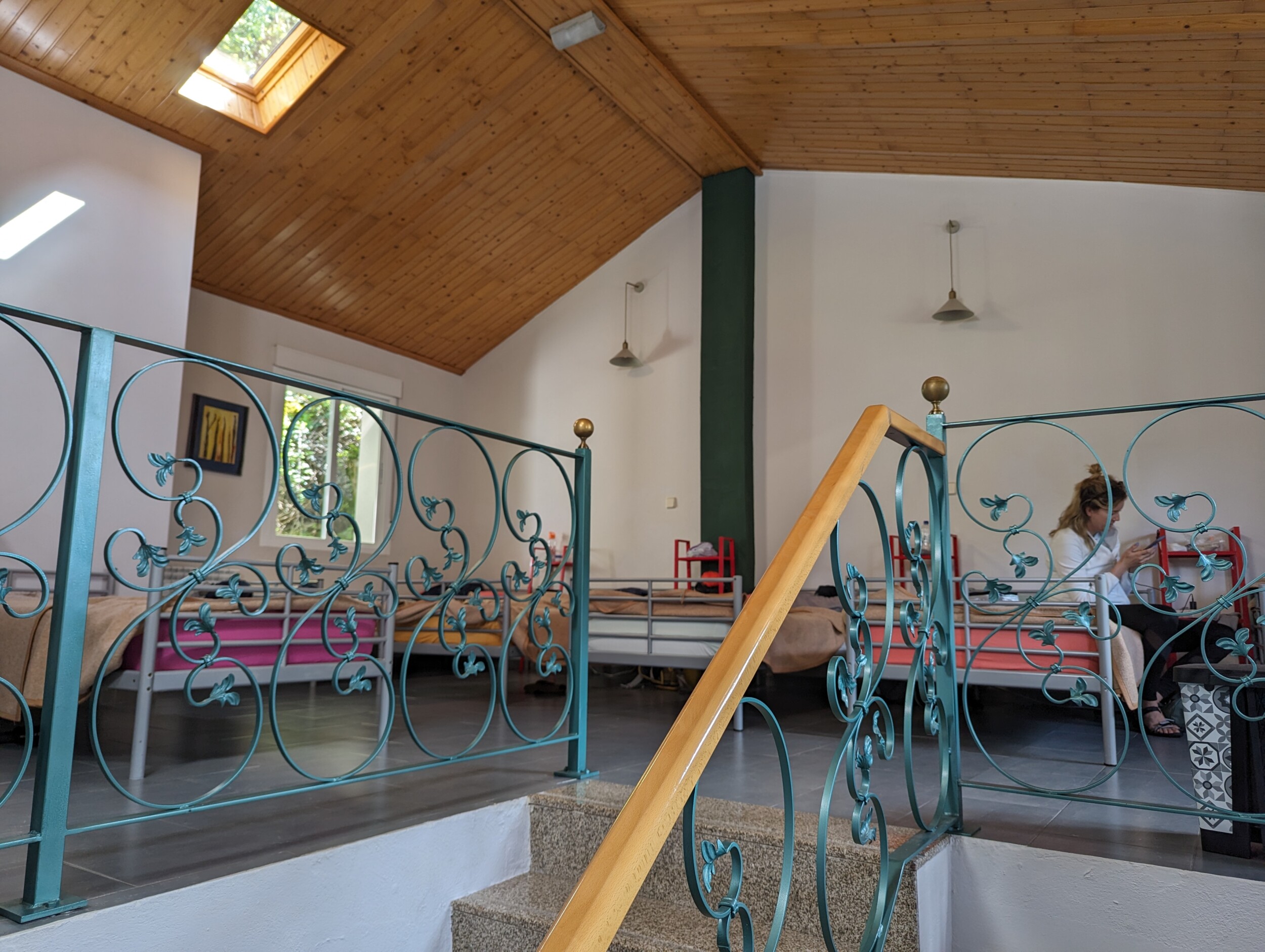
Finally, you have the donativo hostels, also often municipal, and there you give what you can spare for a night and this is therefore the most basic. Prices range from donation to approximately 25 euros per night and everything in between.
- How long can you stay in a hostel?
Normally, you can stay in a hostel for 1 night. If you’re sick, it will be considered and an exception will probably be made once. The rule is that in the morning at 8 o’clock you’re walking again.
The doors of a hostel also often close at 10 PM in the evening. The lights often go out around 10:00 or 10:30 PM. The hostels are really for the pilgrims and want to give you a good night’s rest. It should also be quiet after that time in the hostel.
Know that pilgrims on foot have priority over pilgrims on bicycles at the municipal hostels. This distinction may not be made at the private hostels; they must accept everyone.
You are welcome to stay overnight in a hostel on the Camino de Santiago if you can also prove that you’re a pilgrim. The hospitalero/a will ask you for your pilgrim passport. With this you prove that you’re a pilgrim who is doing a pilgrimage. Every day you collect stamps in it to prove which Camino you’re walking. Sometimes they check where you spent the night before to check if you’re actually walking or cycling. And therefore not making too large distances and possibly traveling differently.
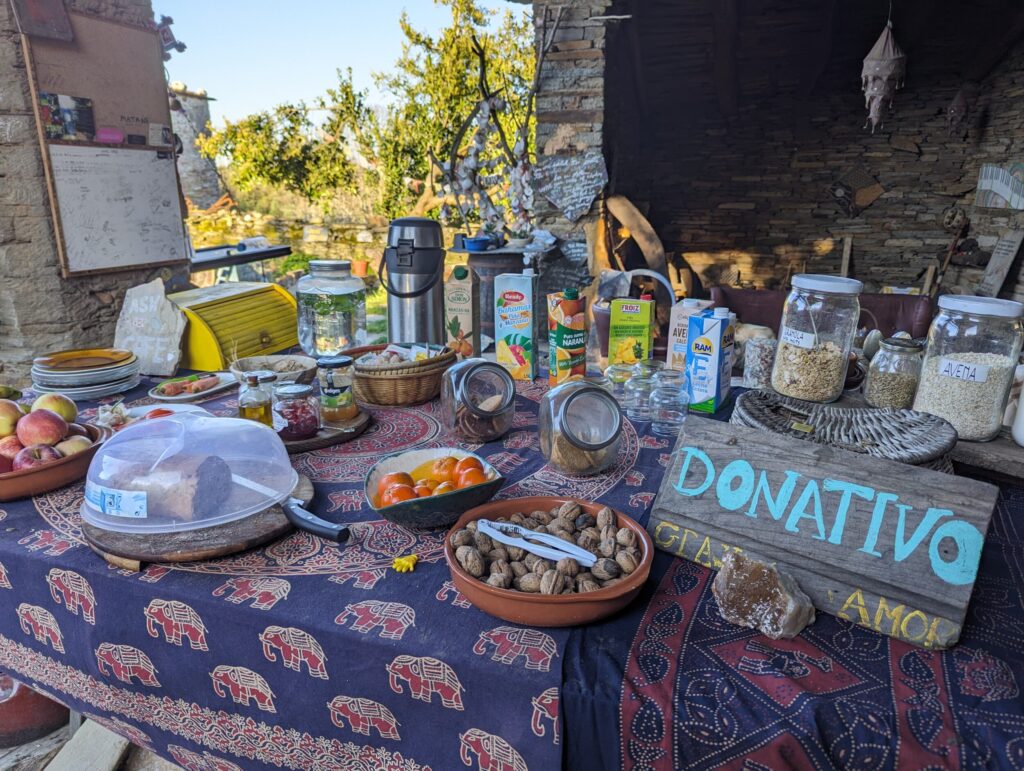
- When are hostels open?
Hostels are often open from Easter, around mid-April, until around November. Do you want to walk the Camino in the winter months? That’s certainly possible. A number of private hostels will be open and also a number of hotels are of course open and have adjusted prices. Just know that you can’t then stay in all villages along the way. And that a bit more planning is needed in advance of where you’ll spend the night. The websites caminosleeps and gronze or the BuenCamino app will definitely come in handy then.
- Bed bugs in hostels
Fortunately, I’ve never had any problems with them. Whether that’s also partly due to my silk liner (I’ll explain why later) I don’t know, but I’ll knock on wood! Keep in mind that there can be bed bugs in hostels. Later in the season you have more chance of them than at the beginning, when we just come out of winter. Places with old wooden floors and beds, woolen blankets and old mattresses are perfect places for bed bugs. It’s an idea to check your mattress in advance.
How do you check for bed bugs? Look at the underside of your mattress for black/reddish-brown dots (droppings or crushed bed bugs). But also look at the seams of the mattress or between the slatted base.
How do you recognize if you have or have had problems with bed bugs? The bed bugs bite and you get irritation and itchy spots from them. These spots can be recognized by the fact that they are usually in a line on your body. That line runs over a vein; the bed bugs live on blood.
Travel guide for staying overnight on the Camino de Santiago
By now I’ve told a lot about life in the hostels and now tips to have a good night in the hostel on the Camino. To sleep well and comfortably in the hostels, there are a number of products that are really indispensable if you ask me. I’ll list the most important ones for you.
Sleeping bag / Silk liner is indispensable
A nice silk liner/sleeping bag is the most important thing when staying overnight on the Camino de Santiago. I always have the Cocoon silk liner and this year I bought a wider one, the liner XL. This is 114 cm wide and also a bit longer. I like to lie a bit wider and occasionally pull up a leg… that’s difficult in the standard size of 90 cm.
Why do I recommend a silk liner? There are several advantages to silk over cotton. First, silk is lighter than cotton. That’s of course worth a lot when you carry the package on your back every day. In addition, it’s smaller, so the package also takes up less space in your backpack.
And what’s also an important aspect of silk. It protects you against vermin, bites from bugs or whatever. It’s recommended if you go to warmer regions… but also in hostels where bed bugs can occur… Silk liners are more finely woven and those bugs can’t get through. I’ll gladly pay those extra euros for that!
A tip you might also come across in your preparation is: Never put your bag on a bed to prevent the spread of bed bugs. Keep your bag free from any vermin, which you take to the next hostel!
Earplugs
During your stay on the Camino de Santiago, you will undoubtedly encounter snorers and you want to protect yourself against that. But also know that there are always people who decide they want to leave at 5 o’clock, for whatever reason. In a room with multiple people, you’ll always hear sounds from your fellow pilgrims. Good earplugs are therefore indispensable on the Camino.
Light / Headlamp
If you need to go to the toilet at night, it’s nice that you have some light in a dark room where you don’t know the way. Where of course multiple people are sleeping that you don’t want to wake up. A small light is handy to have then. Of course, you can also use your phone for this.
In addition, there are headlamps that have different settings, e.g. red light and white light. Red light illuminates enough to see where you want to go but is not so penetrating that you wake up from it immediately. You could then use the white light afterwards if you’re the one who starts walking before sunrise and wants to light up the path ahead.
Plastic bag / packaging
If you can take this into account when packing your bag, your fellow pilgrims will be grateful to you. When packing or unpacking items, you’ll always produce sound, but a plastic bag rustles very loudly. Sound travels far in a quiet space and people wake up from it. You want to prevent this of course. Take a critical look at your bag and how you can prevent producing too much noise when you’re going to pack your bag in the early morning.
I use plastic vacuum bags in my backpack and pack them before going to sleep. The last clothing goes into the bag loosely in the morning.
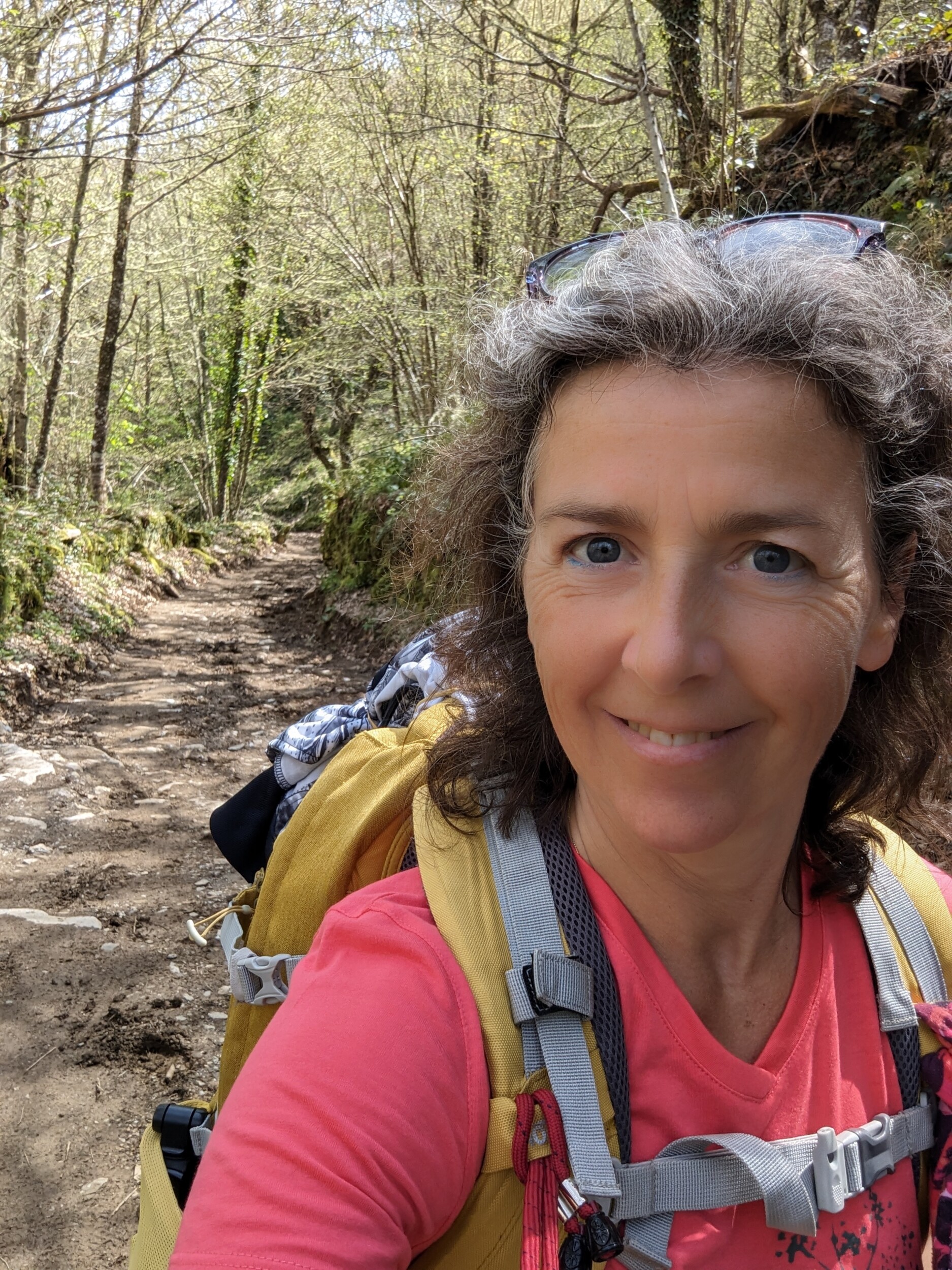
Showering in the hostel
Showering in a hostel requires some preparation. A quick-drying towel is indispensable on the Camino. You want everything to dry quickly, including clothing etc., but a ‘large’ cotton towel absorbs a lot of water. If you have a quick-drying specimen, you know for sure that it can go back into your backpack dry the next day. Another advantage of a quick-drying towel is that it’s lighter and more compact than a regular towel.
How do you stand in the shower cubicle? If you don’t want to stand here barefoot, you can take extra flip-flops for this purpose. I don’t think it’s worth it to take extra flip-flops for this purpose, but if you have sensitive feet, this is definitely worth considering. Those feet have to bring you to the final destination, right? These shower sandals weigh 200 grams and are the lightest I could find.
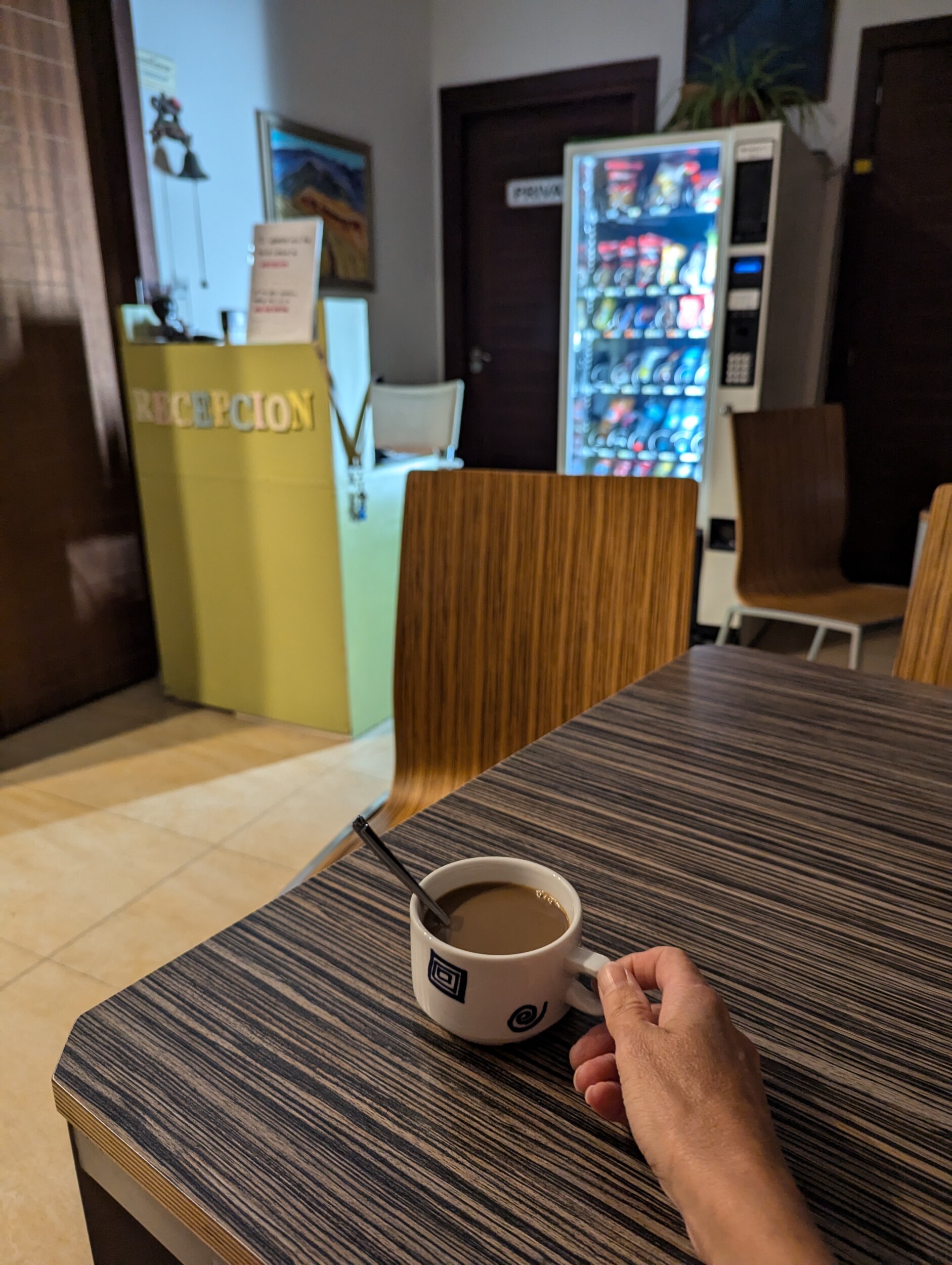
Washing clothes in the hostel
If you walk for days on end, you’re not going to carry your dirty laundry with you. At least, that’s not effective of course. You take with you what you use and everything you don’t need is unnecessary ballast. So every day you wash out your dirty clothes so that you wear the other clean set. So bringing some detergent is a must.
Sea to Summit has a special outdoor wash. You can use this as detergent but also as shampoo and body wash. Perhaps the best option to take as a pilgrim.
Most hostels have clotheslines or places made so that the pilgrim can hang up his/her laundry. Yet it was sometimes handy that a fellow pilgrim had a clothesline and where the clothesline was full, created a clothesline above the bed or elsewhere in the hostel.
Keep in mind that if you fly and only take hand luggage, you may of course not exceed 100 ml. Somewhere I found a small 100 ml detergent package. Otherwise, it’s also an idea to take washing powder or wash strips.
Sarong or Pareo
Something that has been in my travel bag for years is a sarong/pareo. I use this sarong for so many purposes that I always take it with me again. Even in a hostel you can use the sarong for extra privacy. You then hang it in front of your bed as a partition to the large space. But also at night for extra warmth, for example. You can easily lay it over the silk liner as an extra layer.
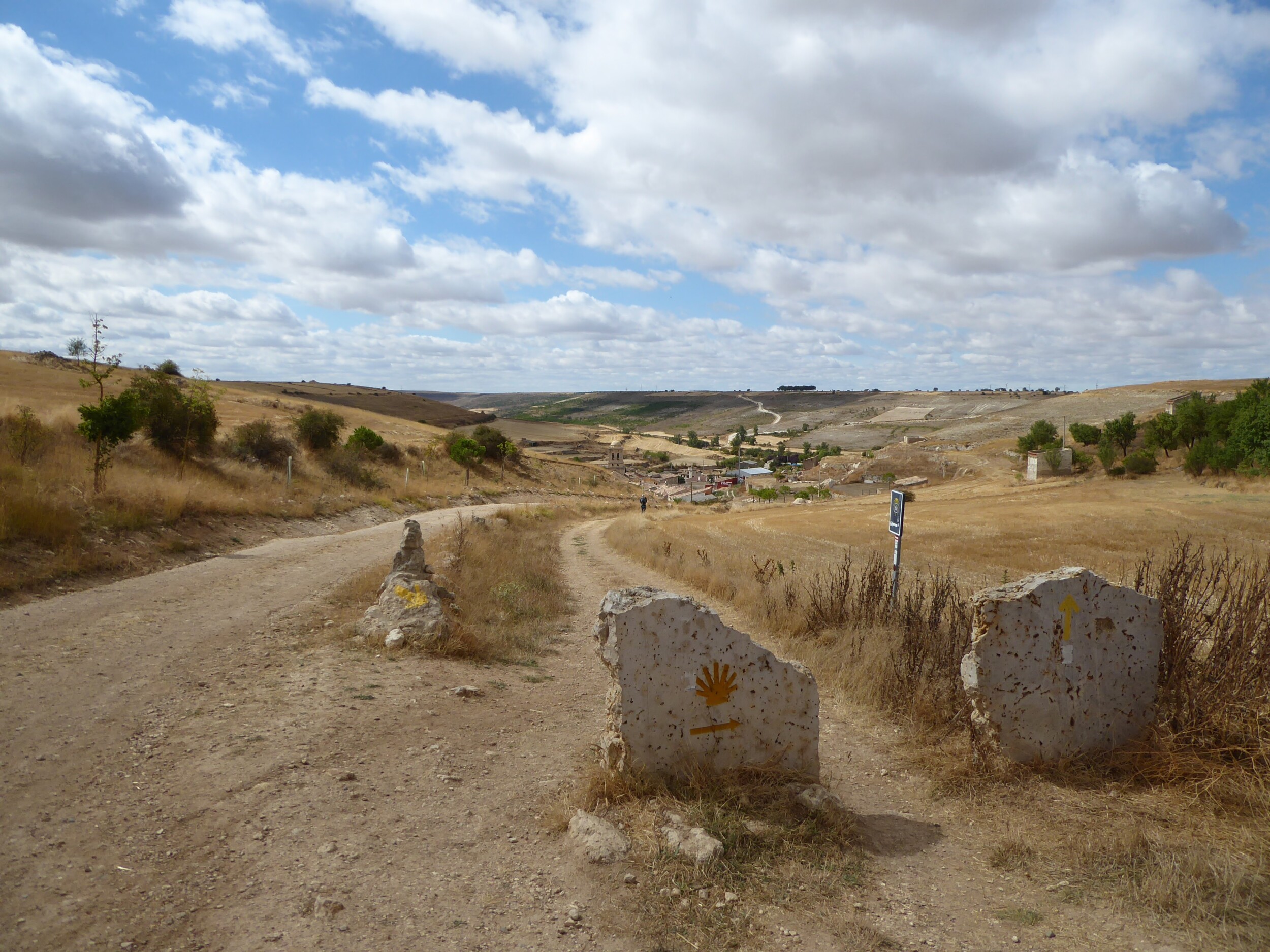
I also use it to sit on the ground along the Camino and even as a scarf in the evening when it gets a bit cooler. For me, this is an indispensable item in my backpack. The sarong weighs just over 100 grams, but I’ll gladly pay that price. I can stuff it away in a corner or it hangs on the outside of the bag. There are different sizes, but if you also want to use it as a blanket or picnic cloth, I can recommend the 100 by 200 cm one.
How do you leave your belongings in the hostel?
After you’ve checked in at the hostel, showered and the laundry is hanging to dry, you want to explore the village or city. How do you leave your belongings in the hostel then? It’s very rare that items are stolen, but you can’t completely rule it out. So you always take some risk leaving your belongings unattended.
What I always do when I leave the hostel in the late afternoon or early evening is that I take my valuables with me. I have a small bag with me to keep my valuables with me when you’re going to explore the village.
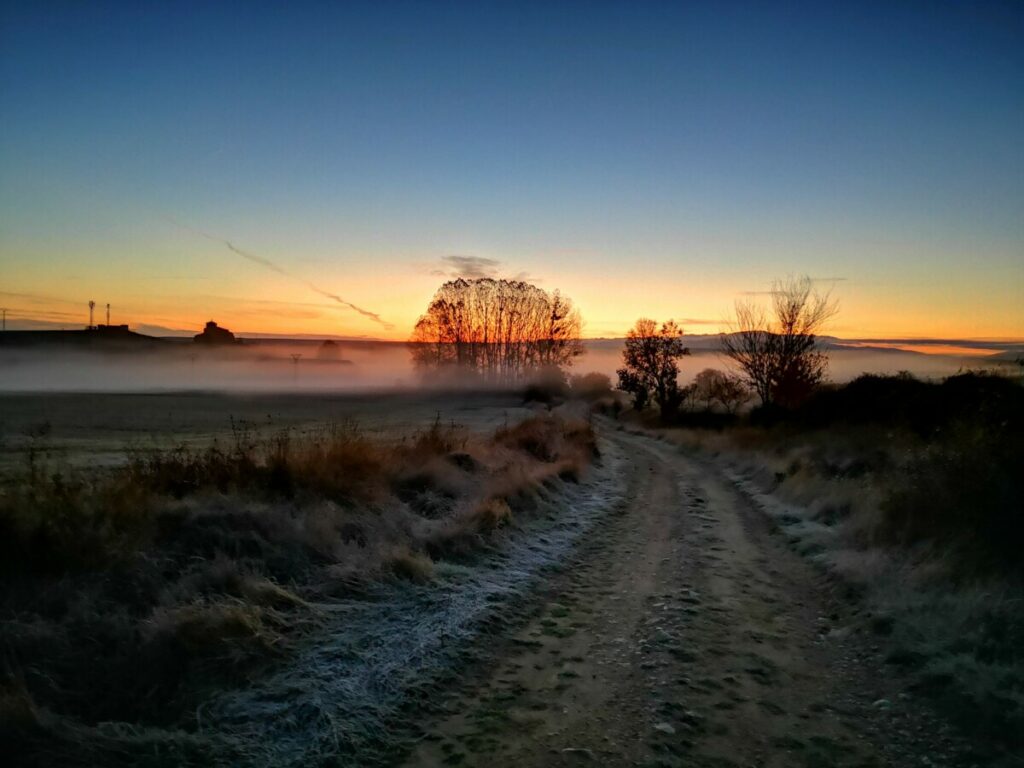
If you still have valuables in your large bag, you can use a lock to close your bag. The better backpacks all have a double zipper so you can connect them together with a lock. If you buy a lock, I can recommend the TSA lock.
Can you sleep outside on the Camino?
I still come across that question sometimes. It is forbidden in Spain to just sleep somewhere along the roadside. If you want to sleep outside, you must do so in a tent at a campsite. The Camino is not really set up for this. But you can of course sleep partly at a campsite and partly in hostels. You then also drag all your equipment with you to be able to sleep outside.
Do you still have questions after reading this blog about staying overnight on the Camino de Santiago? Feel free to ask me!
Come and Join me on the Camino de Santiago!
